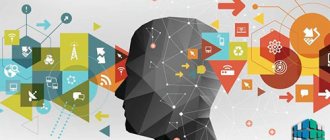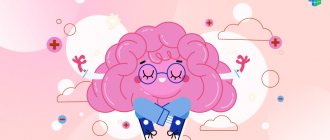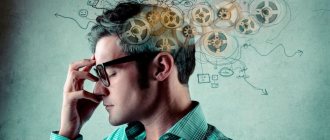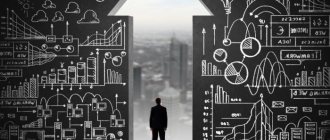Thinking in psychology and neurophysiology is considered as a process of concrete or abstract, abstract reflection of reality in the psyche of the subject, through the objectification of things, phenomena and connections between them. The classic method, known as convergent thinking, relies on clear laws and frameworks that are used to instill an academic style of thinking. This is precisely the paradigm that is taught to schoolchildren and students in the countries of the former Soviet Union. Is this the only way to reflect reality and find truth? No, not the only one and relatively ineffective in many cases, which is not taken into account when planning to solve certain practical issues.
Divergent thinking is a fundamentally different paradigm of mental activity, based on creativity and the ability for paradoxical thinking, multivariate conclusions and results of the activity process. What is it, in simple terms? It is necessary to consider divergent thinking in conjunction with convergent thinking.
If convergent or typical is based on the ability to linear process, then the other is based on a multivariate approach. The examples are simple. There is a specific task. Convergent thinking involves the use of a ready-made algorithm, one of the approaches that were developed earlier. Because the result will be guaranteed and understandable. As for the second approach, a person applies fundamentally new techniques, modifies algorithms or uses his own, created based on experience. The results can be very different, but a beneficial effect is always achieved.
Modern academic methods are gradually retreating; the main place is occupied by syncretic methods of mental activity, based on linearity and multivariance. You can learn divergent thinking at any age. With the right approach.
Definitions
For a long time, logic was considered the basis of the thought process. Even translated from ancient Greek, logic is the science of correct thinking and the ability to reason. In schools to this day, the ability to reason logically is at the core of successful learning.
The type of thinking aimed at solving various problems using a clear algorithm of actions is called convergent.
It was this type that we used in algebra lessons, when we were looking for a solution to a problem using a new formula we had learned. There was only one correct answer. In simple words, convergent thinking involves finding the only correct solution based on existing data.
By the middle of the 20th century, people realized that logic is often powerless in solving complex non-standard problems. The reason is the linearity and one-pointedness of this type of thinking. But such dilemmas were easily solved by people with a creative streak who were lost in the face of logical problems. It was a different type of thought process.
Divergent thinking is a method of creative thought process that involves finding multiple correct solutions to the same problem or task.
The first who began to study logical and creative thinking and gave them the names divergent and convergent was the American psychologist and professor Joy Paul Guilford.
You can read about the main types of thinking and their characteristics in our previous publication.
Fundamental differences from the linear or convergent method
There are several fundamental differences between divergent thinking:
- Nonlinearity
When working with a group of objects and methods, such an individual achieves a group of results, each of which satisfies the set goal, the effectiveness criteria that were developed before the start of the activity. The convergent approach presupposes a clear algorithm for achieving a specific goal. And nothing else. The methods of such a paradigm are especially noticeable in technical activity with a creative component, programming, etc. A program can be created in different ways, but a good specialist strives to work through several options and choose the optimal one in terms of the consumption of machine resources and the final result.
- Lack of a clear set of actions
The algorithm can be taken as a basis, or a person works out his own way to achieve the goal. Both options have a right to exist. It all depends on the specific tasks and the desired result. At the same time, there is a reliance on knowledge, and not bare experiments. Programmers use methods of mathematics and graph theory as a foundation, but do not use templates; they develop algorithms independently, for specific technical needs. Or a cook. They know the technology of processing products and take into account their compatibility. Then they work according to their own judgment to achieve taste and other necessary properties.
- Versatility
Tension of the forces of the whole brain (both the right and left hemispheres work).
- Originality
Creative component.
The features of the paradigm are determined by greater freedom, breadth of perception, and sensitivity of the subject. The necessary qualities will have to be developed.
What is the difference
To more clearly show you the differences between these two types of thinking, I will briefly list the characteristics of each of them.
Convergent:
- translated from Latin means “to converge”;
- linear, unidirectional;
- relies on the word;
- focused on finding the only correct solution;
- uses a clear algorithm of actions;
- based on the study of existing ready-made data, rather than on searching for new ones.
Divergent:
- translated from Latin means “to diverge”;
- nonlinear, multidirectional, i.e. it goes in different directions from the key problem;
- relies on an image;
- focused on finding multiple solutions to the same problem;
- acts unconventionally, free from stereotypes;
- endowed with flexibility and the ability to look at a situation from different points of view, perceive and generate new information.
So, convergent, or logical thinking, involves a person focusing on one main solution to a problem and looking for only one answer. Based on facts and arguments. If it does not find that one and only path, then it concludes that the problem is unsolvable.
If the logical follows a well-trodden, shorter and more reliable path, then this does not apply to divergent thinking, because it opens up new unexplored paths. This is where you can accidentally find something unusual and unique.
But is it possible to say that divergent thinking is better than convergent thinking or that they are mutually exclusive? Of course no. Firstly, you don’t always need to complicate things and reinvent the wheel. Secondly, both types can easily coexist in a person. It’s just that we’ve been purposefully taught logic for 10 years, but creative perception often has to be developed on our own.
On a note! It is not entirely correct to equate divergent and creative thinking. Still, creativity goes far beyond nonlinear thinking. But without a divergent method, creative activity is impossible, since it is precisely this method that underlies the creative process.
Structure
The ability to approach tasks and issues in a non-standard way is based on a group of features that make up the structure of the named method of activity. They can be defined as follows.
Objects
Certain objects that are used for further mental manipulation of them to achieve certain goals. These are not always things in the material sense of the word. It may well be that we are talking about extremely large structures that cannot be “identified in nature.” Road, house, planet. Also concepts at the intersection of the material and the abstract: society, etc. Or even ideal, intangible entities. The latter is especially typical for philosophical and scientific knowledge: life, death, love, freedom, the universe, matter, and other categories that do not have material expression.
Approaches
Actually, methodology. A list of methods that are used to operate on objects. Their systematization, analysis, applied use. The methodology is most clearly visible when assessing material, transformative human activity. For example, in the work of an inventor, mechanical engineer, etc.
If the convergent approach presupposes a certain academicism and even stereotypes, action according to a specific algorithm, divergent thinking requires a creative rethinking of given standards. New principles of object manipulation. To exaggerate: a cook with a convergent approach strictly follows the technological map and recipe and does not deviate one iota from them. With non-linear - tries to modify the recipe in order to achieve greater effect, improve taste, reduce cost without compromising quality, speed up the cooking process. In a word - optimize work and achieve better results.
Ideas
The ideas are based on a specific concept based on approximate ways of influencing objects, their combinations, relationships. This is an integral component.
If compared with the structure of the convergent paradigm, everything is simpler; a person using this method has more freedom to express himself and search for non-trivial ways of acting. The linear style has a more rigid structure and has frames:
- objects;
- methods;
- ideas;
- strictly defined algorithms, templates (they can be combined, but you cannot deviate from them);
- signs of objects;
- determination of their functions.
The definition of a divergent type of thinking initially presupposes not a logical, and certainly not a purely mechanical, but a creative approach. Since the structure gives more freedom, it is much more difficult for a person to take advantage of such wide opportunities in the initial stages. Divergent thinking needs to be learned. This is a practical group of skills. However, oddly enough, this method is much more effective if you need to solve problems that do not require a single approach.
According to theoretical and practical research, the greatest efficiency is achieved when it is possible to switch between different paradigms or use them in parallel.
Main features of divergent thinking
In psychology, there are four main properties of divergent thinking:
- Fluency. It means the ability to quickly and spontaneously formulate a variety of ideas for practical problem solving.
- Flexibility. This is the ability to find implicit hidden connections between objects and events, simultaneously think through different options, and switch from one area of analysis to another.
- Non-standard. Allows you to look at familiar things from a new angle and find non-trivial solutions that do not occur to others.
- Elaboration. It helps not only to think through the details of new ideas, but also to find practical application for them.
Pedagogy also highlights another feature of divergent thinking - the ability for independent learning and development through intuitive feeling.
How to check which species is dominant?
Each of us successfully uses the above types, moreover, constantly and even in everyday life. Well, for example, when you are getting ready to go to work, you usually go up to the front door, take out the key to the apartment, go outside or into the entrance and lock the door. A clear algorithm even allows you to relax your mind and do all the actions, as they say, “automatically.”
But the program crashes when the keys are not in their usual place. And here divergence comes in, starting to throw up the most interesting ideas about the location of the required item.
And, despite the balance, each person still has a great predisposition to either convergence or divergence, it’s like with a temperament type. And you can determine predisposition using several ways:
- Try writing a list of 10 points, answering, for example, the question: “Where and for what can I use a thin branch?” And then look at all your options, and if among them the usual use of branches is indicated, for example, for lighting a fire, then you are a convergent, and if your ideas are original, then the psychology of your decisions has a divergent origin.
- Also try to take the test for your IQ level, it corresponds to a pattern and certain clear patterns, so it is difficult for brilliant people to give a definite correct answer. This testing will help not only determine your predisposition, but also reassure you in case of difficulties.
Diagnosis and assessment
The author of the concept of linear and nonlinear types of thinking, Joy Gilford, has developed a set of diagnostic tests that allow you to detect and assess the level of divergent thinking in a person.
This technique evaluates 4 components of creativity:
- Originality.
- Spontaneity.
- Semantic flexibility.
- Adaptive flexibility.
In total, the Guilford method contains 14 tests with a variety of tasks. But due to their complexity, they did not gain wide popularity among psychologists.
More than 100 cool lessons, tests and exercises for brain development
Start developing
These tests were later refined by another American psychologist, Alice Paul Torrance. He revised the evaluation criteria and adapted them to different age categories. As a result, Torrance's techniques became more understandable and became an accessible tool for identifying creative potential.
The most famous optimized test is 10 simple abstract drawings that need to be completed into meaningful images and also given names. The results are assessed according to 4 criteria:
- Idea development.
- Speed of execution.
- Originality.
- Flexibility.
Torrance also has other techniques, such as audio and verbal. But the test with pictures found a greater response from both school psychologists and specialists involved in the professional selection of employees.
You can familiarize yourself with the tests for divergent thinking and pass them in our separate publication.
Divergence in linguistics
Divergence of languages (dialects) is the separation and removal of related languages (dialects) from each other due to socio-historical reasons.
This may occur due to the migration of part of the population to other regions and countries, the division of people as a result of wars, etc.
For example, at the beginning of our era (about 2000 years ago) there was a Proto-Slavic language. By the 500s AD. From this proto-language, several languages emerged, which became the proto-languages of modern languages with Slavic roots.
In the diagram: the difference between divergence and convergence in linguistics :
Factors that hinder the development of nonlinear thinking
Children are endowed with the most developed divergent thinking. Their minds are open to everything new, they are not controlled by dogmas and prejudices, they have a rich imagination and a great desire to learn and develop.
Later, our children's creativity is “pushed” into the framework of the school curriculum and public opinion. We begin to notice that logic rules the roost, and creativity often does not bring success. This is how the creator in us dies and a thinking machine is born.
But it is not only education and society that hinder the development of divergence in us. Let's consider what are the factors that slow down the speed and effectiveness of developing nonlinear thinking:
- Psychotype. Introverts, melancholic people and representatives of schizoid accentuation are more susceptible to creativity. The more similar correspondences there are, the easier it is for a person to be creative. And choleric people and extroverts, as a rule, prefer to rely on logic.
- Health. Some mental personality disorders make the development of divergent thinking impossible or difficult.
- Upbringing. We all come from childhood, we were all raised differently. If parents justified their requests with the words “Do it because I said,” then the initiative and motivation in the child are stifled, and it is difficult to create in such conditions.
- Close surroundings. In an environment of like-minded creative people, it is easier and faster to open up and cultivate creativity within yourself. The opposite situation occurs if the environment does not match such a request.
Features of thinking
The main role in finding optimal solutions, including generating ideas, belongs to thinking. The essence of thinking is the search for answers and the desire to understand reality. When a person thinks, he activates many mental processes: attention and observation, curiosity and recollection, evaluation and interpretation, imagination and fantasy, memory and cognition.
It happens that a person is well educated, he knows a lot. Can all such people successfully solve life and professional problems? Having a large amount of knowledge does not at all guarantee that a person will be able to quickly and effectively use this knowledge. When faced with a complex task, even an erudite can get lost and fail to respond with the speed and quality of the proposed solution. In this case, it is important to be able to think qualitatively. And learning to think quickly and, moreover, offering several options for solving a problem, will help the development of creative thinking, one of the types of which is divergent thinking.
How to develop
As we have already found out, we are all born creative. Stamps and dry approaches are laid in us later. And the more mature the age becomes, the more difficult any learning becomes. In an effort to develop divergent thinking, many will have to build skills literally from scratch and awaken what was deeply buried in the subconscious and forgotten.
Based on the presence of the factors listed in the previous section, the degree of suppression of divergence is different for everyone, and therefore the efforts to transition to a new type of thinking will be different for everyone.
Here are the main ways of development:
- Search for non-standard connections. Take two fundamentally different objects for comparison. For example, a hat and a pencil, a star and a ship, etc. Now try to find similarities between the selected objects.
- Generating unusual ways to use an item. Let's take a paper clip as an example. How can it be used besides securing papers? Use it to connect keys, close a carton of milk, secure the door of a parrot's cage, etc. Another example is a brick. What can you do with it besides construction? Use it as a press, prop up a door, use it in martial arts to hone techniques, etc. I think the principle is clear.
- Word game. Think of as many words as possible that end with the letter you choose. The rule can be changed, for example, so that words end with two selected letters or three.
- Brainstorming method. Suitable for cases when you are faced with some task that requires a solution. Take a piece of paper and a pen. Spend 5-10 minutes and write down everything that comes to mind on this topic. Don't judge your ideas, they can be anything: stupid, illogical, fantastic, impractical, etc. Write everything down. This is a great way to find unusual and creative solutions.
- Intelligence map (mind map, mental map). It is a method of depicting a problem using a graphical diagram or diagram. Draw a circle with your problem in the center of a piece of paper and create branches: some of them will represent ideas for a solution, some will represent the possible consequences of their implementation. Read more about the benefits of mind maps and how to create them online on our blog.
- Associations. You will again need a piece of paper. Come up with any word, write it down at the very top of the sheet, and then draw 5 arrows from it and write down an association for this word under each of them. For example, take the word “summer”. Associations to it are the beach, sea, hat, vacation, sun. Now draw 5 more arrows from each association and come up with your own associations for each concept. And so on.
- Search for new solutions. Try to find several different approaches to a solution in any situation. Even in the most everyday cases. For example, you need to pay for housing and communal services. How can this be done? You can go to the bank and pay through the cash register, or through the terminal, you can select the payment method through online banking in the mobile application, enter the details or use the QR code.
I suggest you familiarize yourself with interesting exercises for developing creative thinking.
Divergence in biology
Identical species of flora and fauna, being in different conditions of existence, acquire new features that differ from the features acquired by the same species in a different habitat. This process is called species divergence .
Charles Darwin (an English naturalist who lived in the 19th century) substantiated the theory of evolution (how is that?), according to which all types of biological organisms evolve through natural selection.
Darwin concluded that divergence and convergence in biology are mechanisms of natural selection.
Let me remind you that convergence in evolutionary development is the appearance of similar features in different species of flora and fauna when they exist in the same habitat. More details about this in another article on our blog.
A clear example of divergence in the animal world:
Once upon a time, due to natural disasters and migrations, bears “scattered” around the world and found themselves in different natural and climatic conditions. The result was a change in appearance.
Animals, adapting to new conditions of existence, acquired new unique features. Thus, the bear population branched out and new species of these animals appeared.
Is there a piece of originality in every person?
Every person is divergent to some extent. The uniqueness of personality has been proven for centuries; there are no two similar mindsets on the planet. This is the originality of the approaches of many inventors, philosophers, and researchers.
A person’s worldview functions as a driver for freedom of thought or, conversely, becomes a blocker on the path to changing life priorities. Even in childhood, the concepts of rationality, good and evil, which initially do not have a one-sided interpretation, are embedded in a person’s consciousness. Each individual is forced to learn these criteria independently, forming divergent or convergent thinking.
Joy fuels your imagination
There is such a concept from the famous psychologist J. Nina Lieberman called the “Joy Manifesto”. It turns out that in order to think creatively, some other conditions are necessary, such as:
- Joy
- Good mood
- Optimism
- A good relationship
- Sufficient rest
- Life without stress and tension
- There shouldn't be any anxiety
- Inner well-being
In a word, a person must be in harmony with himself, then he generates new ideas and he can go in different ways, knowing for sure that even if he “falls, he will rise easily” and go a different way! And this is all due to divergent thinking... this article is about that!
Join us on the Yandex.Zen channel










